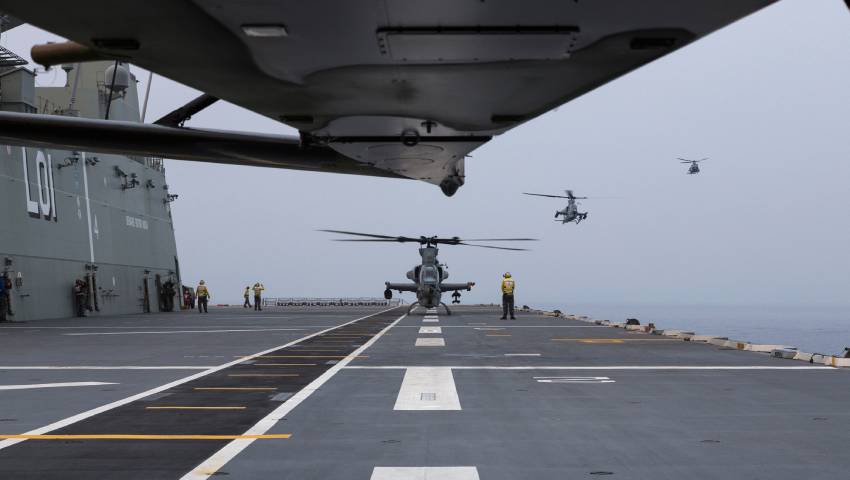With three main solutions leading the race for Defence’s LAND 4503 Helicopter Replacement Program, one of the competitors, Bell Flight, joined Defence Connect to give a rundown of its offering: the AH-1Z Viper.
To continue reading the rest of this article, please log in.
Create free account to get unlimited news articles and more!
With the Australian Army looking to replace its current fleet of EC665 Tiger armed reconnaissance helicopters (ARH) over the next decade, Bell Flight believes it is best positioned to fill the capability.
LAND 4503's program of delivery aims to support the Australian Army and is designed to contribute to the creation of the modernisation and development of a 'networked and hardened' Army, the acquisition is broken down into three delivery stages beginning with projected IOC in 2026 and FOC in 2028, including:
- Up to 24 aircraft would be based at one primary location and another five are intended at a training location. The aircraft fleet may also be co-located in one primary location, however this is yet to be determined.
- IOC for LAND 4503 is based on a squadron of up to 12 aircraft. This organisation would be capable of generating a deployable troop of four aircraft, continued force generation of four aircraft, and an initial build-up training element of four aircraft. IOC will be supported by trained personnel and support systems.
- FOC for LAND 4503 is based on a regiment of up to 24 aircraft. This organisation would be capable of generating multiple concurrent deployed forces of up to squadron size. FOC will also be supported by a mature training system of up to five aircraft, with trained personnel and support systems.
Bell, a subsidiary of Textron, is presenting the AH-1Z Viper, currently in service with the US Marine Corps, which has been designed and built to support the expeditionary and maritime-centric focus of operations conducted by the US Marines.
Bell Flight’s international military campaign manager, Javier “NERF” Ball, and LAND 4503 capture team lead Rowan Tink joined the Defence Connect podcast to discuss the Viper platform.
Can you tell us a little bit about this asset? How does it differ from the other offerings for the LAND 4503 program?
Ball: The AH-1 Zulu (AH-1Z) is designed from the get go to fly off ship.
It's designed to operate in those harsh environments that the Marines are going to be in, so when we talk about the design in the aircraft, that goes more than just corrosion control.
We do wet lay up, we do all the seals. The blades have a semiautomatic blade folding, so that way we can maximise all the space on the ship.
But then, all the avionics, all the systems, all the ordnance is optimised to not interfere with the ship systems.
So, the way we look at it is, if I can build it to the hardest environments that it's going to be in, which is salt air, salt spray, and it can operate there, then it's easier to take it, an amphibious aircraft, and put it in an expeditionary environment where I have to operate either in the snow, or in the jungle, or in the sand, or the mountain area.
Rowan, when you think about the utility of these platforms running off our landing helicopter decks (LHD), and now you've had some experience with the LHD, how do you think that would interface in?
Tink: That will integrate very smoothly into the LHD. They can operate off a whole range of the Australian Navy ships, an LHD, LSD for example, and even smaller ships if necessary.
So yeah, in terms of a capability, they are unique and just adding to Nerf's part.
The Australian Army, for example, will focus on the hardest part of operations, [which is] arguably in the jungle environment, and the helicopter is very much the same.
It's designed for the hardest environment, and anything less than that, it's still more than capable of achieving that outcome. And the marinisation, for example, will provide all the same benefits in the desert. And indeed the Zulu has operated in Afghanistan and has operated in Iraq, and did so beautifully.
How would a helicopter like this be used operationally for Australia?
Ball: Australia has a couple options with us and that's one of the things I'd like to talk about. When you get an aircraft that is marinised from the get go, designed to operate off ship, now you provide options to government.
You can use it in an expeditionary environment, where it's rapidly deployable via C-17.
You can use it in a jungle environment, or you can move it and operate it off ship, with no degradation capability. Because it's designed to fold up, it's designed to withstand the rigours of the salt spray, the salt sea.
When you have options like that, you decrease costs to government. And because of the way it's built and designed for ease of maintenance, you don't have a large contractor footprint that has to do maintaining on it.
Your average digger can actually work on the airplane, and the cost per flight hour for the Zulu is right at about $4,000 per flight hour, US dollars.
Our nearest competitors are upwards of $5,100/$5,200 US dollars, and that's even before they go on ship. Ours is calculated both with flow and ashore combined. So, in the long term, over the life of the program, there's going to be significant cost savings to the Australian tax payers. You can use that money for something else.
For the full podcast, click here.

 Login
Login







